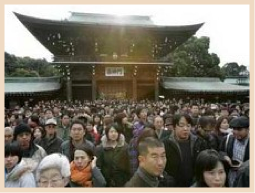
Todd Jay Leonard, Blog


This column is the last of the three-part series on visiting Tokyo as a tourist. A reader wrote to ask what I recommended doing and seeing while visiting Japan's capital city.
One aspect of Japan that I am regularly impressed with is how elegant and courteous department store clerks are when serving the store's customers. Few countries do department stores as well as Japan. Sleek, modern, trendy and swanky are a few words to describe shopping in one of these state-of-the-art emporiums.
If one is lucky enough to arrive as the doors open in the morning, the first customers of the day are treated to lines of perfectly dressed employees in neatly pressed uniforms and suits greeting shoppers with deep, respectful bows.
It is this type of detail that make Japanese department stores stand out from the ordinary. Also, women clerks are strictly trained in how to speak and how to gesture toward customers, incorporating only the politest of language while using the most graceful of hand movements.
The first-time visitor to Tokyo would do well to see the Tokyo Tower. Not because as a structure it is so unique (the Eiffel Tower of Paris is much more quaint), but because it offers a bird's-eye view of how endlessly expansive Tokyo appears to be.
Tokyo Tower's bright red and white steel frame is tacky at best, but on a clear day one can catch a majestic glimpse of Mount Fuji, along with all the skyscrapers and buildings that are packed together in every direction.
Time permitting, a few days in Japan's ancient capital, Kyoto, is a trip worth taking. Kyoto offers so much to the visitor who wants to experience traditional Japan; ancient temples, shrines, pagodas, and near there, Himeji castle that is an original structure that was spared destruction by early reformists and the odd lightning strike.
I would be remiss if I didn't promote my lovely city - Hirosaki, Aomori Prefecture. Albeit smaller in scale than Kyoto, Hirosaki offers many of the same traditional structures (including an original castle guardhouse), but in a setting that is more serene and less crowded. It is called the "little Kyoto of the north."
Occasionally, I receive visitors from home who want to see a part of Japan that few ever get a chance to experience. It is quite a trek to get here, though, which precludes visitors from just dropping by. A real effort and advance planning is needed to come to the hinterlands of Honshu island.
However, if Tokyo is the only place on your itinerary, the determined tourist can indeed experience traditional Japan there, as well. I highly recommend a visit to "Meiji Shrine." Strolling through its meticulously kept grounds makes one forget that outside the gates is the hustle and bustle of downtown Tokyo. If you're lucky, a newlywed couple in kimono may be getting a formal wedding photo taken with the shrine as a backdrop.
Another Shinto shrine that is fun to see is "Asakusa Shrine." Slowly making your way to the shrine down the narrow street is the fun part. Lining each side of the street are traditional stalls and shops hawking everything Japanese from food to trinkets.
The Imperial Palace is interesting to see because of its extensive gardens and grounds. Of course, tourists do not get anywhere near the imperial family's quarters, but visitors are shown enough to get an idea of what life must be like behind the imposing stone walls and moats. There are some really great places to get snapshots with buildings and palace walls as background.
The "Ginza" is internationally notorious for having some of the priciest real estate in the world. After World War II, this area of Tokyo quickly became the center of high fashion and high prices. If you are in the market for a strand of cultured pearls, this is the place to go. Mikimoto's flagship store is located in the heart of the Ginza.
The areas of "Shibuya" and "Harajuku" are where the young and fashionable hang out. When my friend Chris Wissing visited from Shelbyville, she insisted upon standing for several minutes just to "people watch" because any and every type of fashion trend can be seen in these two areas. It offers a glimpse into what's hot and what's not in the Tokyo fashion world. Japanese young people take fashion and accessorizing quite seriously; if it's in style, it will be seen here.
Outside Shibuya Station is a crosswalk that is worth experiencing once. When the light turns green for pedestrians, literally thousands of people crisscross the wide avenue in every direction making a newcomer dizzy trying to take it all in, while at the same time, trying to avoid getting trampled.
In Harajuku, a narrow alleyway running a number of blocks called "Takeshita Dori" is heaven on earth for young people trying to find the latest apparel, shoes, bags or other fashion-related goods. A word of warning: It is usually wall-to-wall people, so you must charge forward aggressively to make your way, like salmon swimming upstream.
At the other end of Takeshita Dori, it is a short walk to the Champs-Elysées of Tokyo - Omotesando. This tree lined boulevard caters to the well-heeled and trendiest of shoppers. Where the Ginza attracts older, wealthy shoppers, Omotesando is geared toward the mid-20s to mid-50s business and career minded crowd.
A new shopping plaza recently opened there called "Omotesando Hills" which is very high-end and elegant. It is enjoyable to stroll in its uniquely designed mall that goes deep underground. The actual physical space is quite small in comparison to malls in other countries, but the architects and designers created an illusion of having vast space in an area that is actually quite narrow.
I recommend the "Oriental Bazaar" on this same boulevard for souvenir shopping. One can find antiques, new or used kimono, as well as ceramics, books and just about anything Japanese in this store.
However, instead of carrying your Japanese baubles and mementos throughout the rest of your trip, you can hold off and visit a branch of the Oriental Bazaar at the airport on your way home. Although it's a much more scaled down version of the main store, there are plenty of souvenirs to choose from and for the same price. There is no mark-up because it's at the airport.
The truly budget-conscious traveler would do well to visit a Japanese version of a "dollar" store called "100 Yen Shop." These stores are everywhere and the variety of merchandise is unbelievable. It is very easy to find Japanese-type souvenirs for family and friends back home. It can be your secret that it cost only 85 cents. One of the few bargains in Japan.
Doing Japan on a shoestring budget is not easy. It is best to come with fistfuls of money, because it isn't cheap. A budget traveler can have an enjoyable stay, but most visitors, after the initial sticker-shock, do eventually succumb to spending more than they intended, no matter how frugal they try to be. It's Tokyo, after all.
By TODD JAY LEONARD
Columnist
Sights to see in Tokyo
Japan’s capital city has wealth of places to visit
Monday, March 26 , 2007







